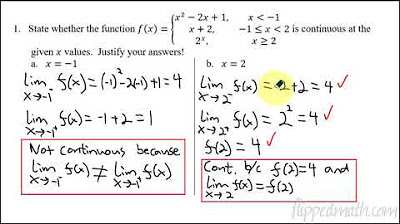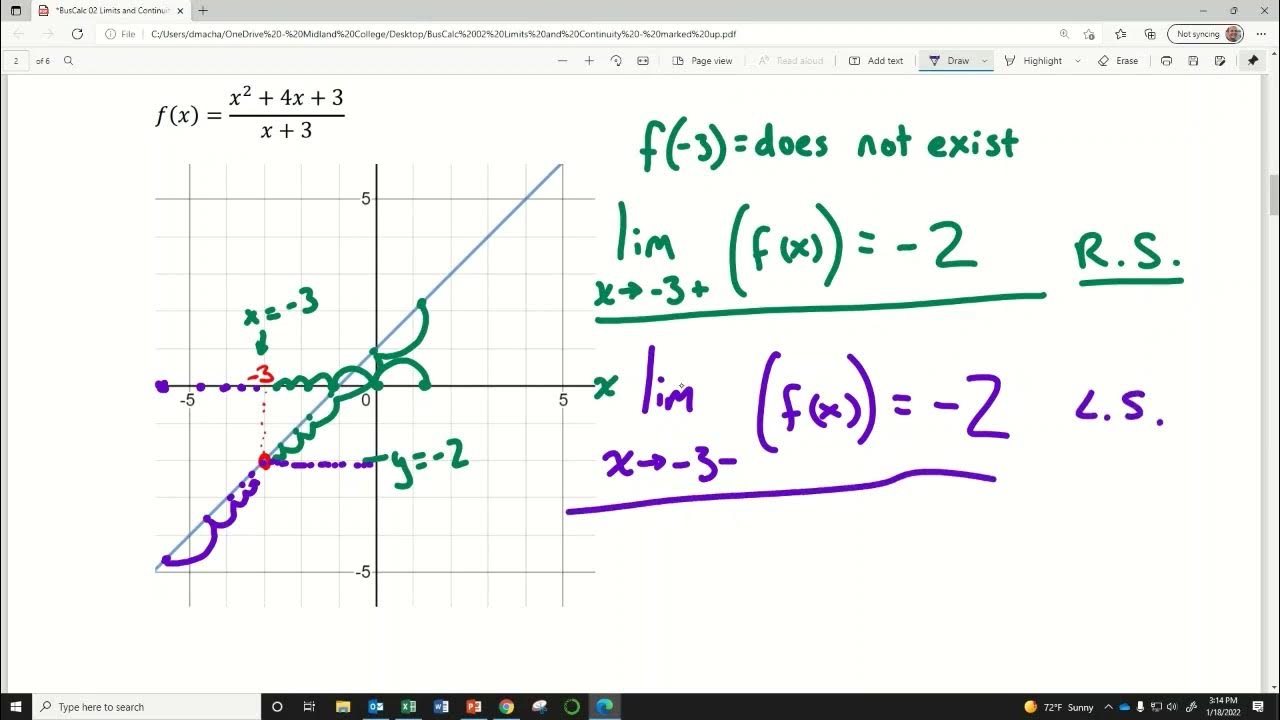Is the function continuous?
TLDRThe video script focuses on explaining the concept of continuity in calculus, specifically for Calculus 1 students. It emphasizes the importance of understanding how to determine if a function is continuous at a given point, using the point when X is two as a case study. The video outlines three conditions that must be met for a function to be considered continuous: the function's value at the point must exist, the limit of the function as X approaches the point from both the right and the left must exist, and these limits must be equal to the function's value at the point. By applying these conditions to a piecewise function, the video demonstrates that the function is indeed continuous at X equals two, providing a clear and comprehensive explanation of the concept.
Takeaways
- 📚 The video is targeted at Calculus 1 students and those interested in understanding the fundamentals of calculus.
- 🔍 To master calculus, one must be able to answer three key questions related to the continuity and differentiability of functions.
- 🌟 A function cannot be differentiated at a point where it is not continuous, as doing so would be meaningless.
- 📈 Continuity is point-wise; a function does not need to be continuous everywhere, just at the point of interest.
- 🎯 The point of interest in this video is when X is equal to 2, as all given questions focus on this value.
- 📌 For a function to be continuous at a point, three conditions must be met: the function value, the left-hand limit, and the right-hand limit at that point must all exist.
- 🔢 The value of a function at a point is determined by substituting that point into the function's equation.
- 🔄 The function in the video is piecewise, with different expressions for X less than 2 and X greater than or equal to 2.
- 💡 To find the limit of a function as X approaches a point, one should substitute the value of X into the function if it is within the domain of the function.
- 🔄 For the limit to exist, the function's behavior from both the right and the left must yield the same value at the point of interest.
- 📊 The video concludes that the function is continuous at X=2 because the function value, left-hand limit, and right-hand limit all equal 5.
- 📈 The graph of the function shows a continuous curve even where there was a 'hole', indicating the function's continuity across the point X=2.
Q & A
What are the three conditions for a function to be continuous at a point?
-For a function to be continuous at a point, three conditions must be met: the function must exist at that point, the limit of the function as it approaches that point from the left must exist, and the limit as it approaches from the right must exist and be equal to the function's value at that point.
Why is it important to know whether a function is continuous at a point?
-Knowing whether a function is continuous at a point is crucial because differentiation and integration, fundamental concepts in calculus, require the function to be continuous at the point of interest. If a function is not continuous at a point, differentiation at that point is undefined and the process becomes meaningless.
What is the significance of the point X=2 in the context of this video?
-The point X=2 is significant because it is the point at which the continuity of the function is being assessed. All the given questions and hypotheses in the video are focused on determining the continuity of the function at X=2.
How does a piecewise function affect the continuity of a function?
-A piecewise function can affect the continuity of a function because it is defined differently in different intervals. The function may be continuous in each interval but may not be continuous across the entire domain, especially at the points where the definition changes.
What does it mean for a function to be differentiable at a point?
-For a function to be differentiable at a point, it must be continuous at that point. Differentiability implies continuity, but not all continuous functions are differentiable. The function's derivative must exist at the point, which is only possible if the function is continuous there.
How can you determine if the limit of a function exists as X approaches a certain point?
-To determine if the limit of a function exists as X approaches a certain point, you must check if the function values approach the same value from both the left and the right side of that point. If the values are the same, the limit exists and is equal to that common value.
What is the relationship between the limit of a function and its continuity?
-The limit of a function at a point is closely related to its continuity. If the limit of the function exists as X approaches a point and is equal to the function's value at that point, then the function is continuous at that point. The limit provides a way to assess continuity.
How does the video demonstrate the continuity of the function at X=2?
-The video demonstrates the continuity of the function at X=2 by showing that the function value at X=2 exists, the limit from the left exists, and the limit from the right exists and is equal to the function's value at X=2. It also visually describes the function's graph, showing that even though it is a piecewise function, it is continuous at X=2.
What is the significance of the function being equal to the limit at X=2?
-If the function's value at X=2 is equal to the limit as X approaches 2 from both the left and the right, it confirms that the function is continuous at X=2. This is a key condition for the function to be considered continuous at a point.
How does the video ensure the viewer understands the concept of continuity?
-The video ensures the viewer understands the concept of continuity by breaking down the necessary conditions for a function to be continuous at a point, providing a step-by-step analysis of a specific function at X=2, and visually describing the function's graph to illustrate continuity despite the function being piecewise.
What is the role of the function's graph in understanding its continuity?
-The function's graph provides a visual representation of its continuity. Even though the function may be piecewise and appear discontinuous, if the graph shows no breaks or 'holes' at the point of interest (X=2 in this case), it indicates that the function is continuous at that point.
Outlines
📘 Introduction to Continuity in Calculus
This paragraph introduces the video's focus on the concept of continuity in Calculus 1, emphasizing the importance of understanding how to determine if a function is continuous at a specific point. It highlights the prerequisites for learning differentiation and integration, which require knowledge of continuous functions. The video aims to clarify whether a function is continuous at the point X=2, using this as a case study to demonstrate the three necessary conditions for a function's continuity.
🔍 Analyzing Continuity at a Point
The second paragraph delves into the process of determining if a function is continuous at a particular point, using X=2 as an example. It outlines the three conditions that must be met for continuity: the function's value at the point, the limit of the function as X approaches the point from the right, and the limit from the left. The explanation includes a step-by-step analysis of a piecewise function at X=2, showing how to calculate the function's value and its limits from both directions.
📊 Visualizing the Continuous Function
The final paragraph concludes the video by visually representing the concept of continuity through a graph of the discussed piecewise function. It explains how the function appears continuous even with a 'hole' at X=2, which has been filled by the right-hand side of the piecewise definition. The paragraph reinforces the idea that despite the function's unusual appearance, it remains continuous at X=2, as the limit and the function's value at that point are equal.
Mindmap
Keywords
💡Calculus 1
💡Continuous Function
💡Differentiation
💡Integration
💡Point of Interest
💡Existence
💡Limit
💡Piecewise Function
💡Continuity Equation
💡Graph
Highlights
The video is aimed at Calculus 1 students and those interested in understanding the fundamental concepts of calculus.
To master calculus, one must be able to answer three key questions related to the continuity and differentiability of functions.
Differentiation and integration rely on the understanding of continuous functions, as a function cannot be differentiated at a discontinuous point.
The focus of the video is on determining the continuity of a function at the point when x is equal to two.
For a function to be continuous at a point, three conditions must be met: the function's value at that point, the limit of the function as it approaches that point from the right, and the limit from the left must all exist and be equal.
The video uses a piecewise function as an example to illustrate the process of determining continuity at a specific point.
The value of the function at x=2 is calculated by plugging the value into the appropriate piece of the piecewise function.
The limit of the function as x approaches 2 from the right is found by using the part of the function that corresponds to x being greater than or equal to 2.
The limit from the left is determined by using the part of the function that corresponds to x being less than 2.
For the function to be continuous at x=2, the calculated values from the right and left limits must match the function's value at that point.
The video emphasizes the importance of checking all three conditions for continuity and not making blanket statements about a function's continuity.
A graph of the piecewise function is described to visually demonstrate the continuity at x=2, showing that even with a break in the function, it can still be continuous at that point.
The video concludes by reinforcing the concept that if the limit as x approaches 2 equals the function's value at 2, the function is continuous at that point.
The process outlined in the video is a fundamental approach to understanding continuity in calculus, which is crucial for both theoretical and practical applications.
The video encourages continuous learning and emphasizes that understanding calculus concepts is key to solving more complex problems in the field.
Transcripts
5.0 / 5 (0 votes)
Thanks for rating:





